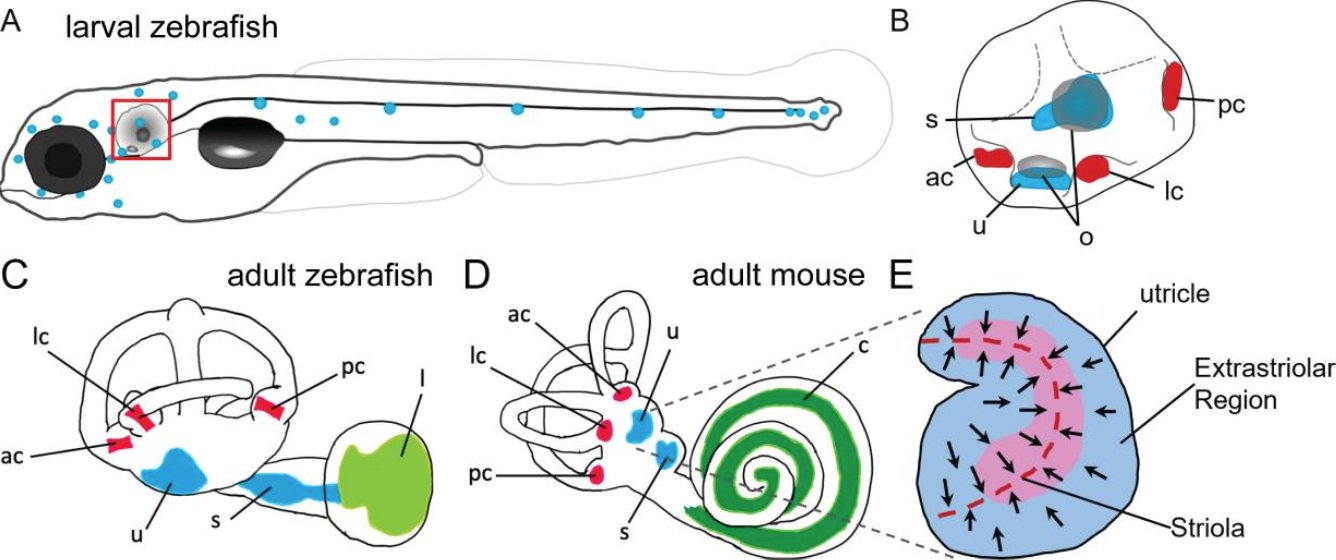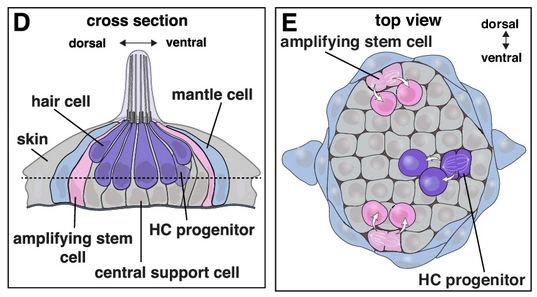Anatomy of zebrafish and mouse inner ears. Credit: Shi, Beaulieu, et al./eLife
A major cause of human deafness and vestibular dysfunction is permanent loss of the mechanosensory hair cells of the inner ear. In non-mammalian vertebrates such as zebrafish, regeneration of missing hair cells can occur throughout life. While a comparative approach has the potential to reveal the basis of such differential regenerative ability, the degree to which the inner ears of fish and mammals share common hair cells and supporting cell types remains unresolved.
In our paper published in eLife in January 2023, we perform single-cell RNA sequencing of the zebrafish inner ear at embryonic through adult stages to catalog the diversity of hair cells and non-sensory supporting cells. We identify a putative progenitor population for hair cells and supporting cells, as well as distinct hair and supporting cell types in the maculae versus cristae, patches of inner ear sensory cells involved in vestibular function.
The hair cell and supporting cell types differ from those described for the lateral line system, a distributed mechanosensory organ in zebrafish in which most studies of hair cell regeneration have been conducted. In the maculae, we identify two subtypes of hair cells that share gene expression with mammalian striolar or extrastriolar hair cells (that is, hair cells in the macula that are either centrally located within the striola, a central zone that includes a line where hair cell polarity changes direction, or more peripheral hair cells located further away from that central line). In situ hybridization reveals that these hair cell subtypes occupy distinct spatial domains within the three macular organs—the utricle, saccule, and lagena—consistent with the reported distinct electrophysiological properties of hair cells within these domains.
These findings suggest that primitive specialization of spatially distinct striolar and extrastriolar hair cells likely arose in the last common ancestor of fish and mammals. The similarities of inner ear cell type composition between fish and mammals validate the zebrafish as a relevant model for understanding inner ear-specific hair cell function and regeneration.
This is adapted from the abstract of the paper in eLife. Hearing Restoration Project member David Raible, Ph.D. (left), is a professor in the department of biological structure at the University of Washington. One of the study coauthors is the late Neil Segil, Ph.D., also in the Hearing Restoration Project, whose lab at the University of Southern California is continuing his work.








Before I discovered CART, I often felt left out, despite being physically present. This gap in awareness affects thousands of people. That’s why I speak up, because access delayed is opportunity denied.